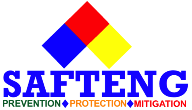Hot Work’s 35′ Fire Safe Area
One of the more common issues we come across in regards to Hot Work is the encroachment of combustible/flammable hazards within the REQUIRED 35′ Fire Safety Zone. 1910.252(a)(2)(vii) Relocation of combustibles. Where practicable, all combustibles shall be relocated at least 35 feet (10.7 m) from the work site. Where relocation is impracticable, combustibles shall be…...
Hot Work’s 35′ Fire Safe Area Read More »
